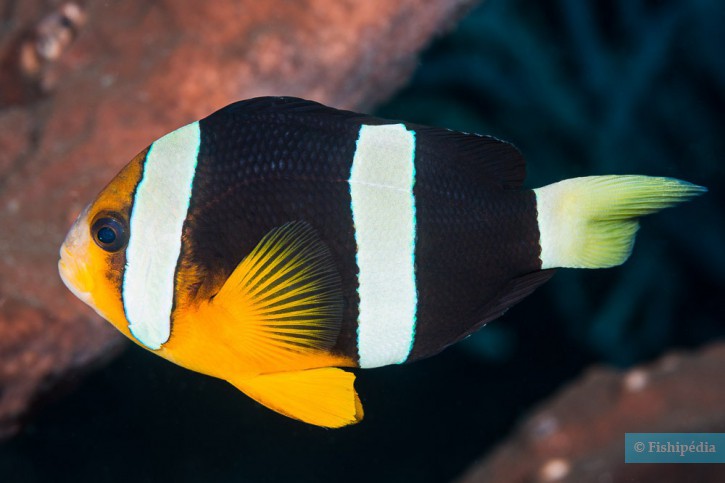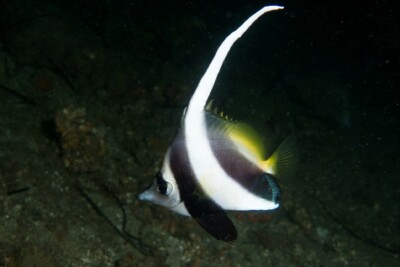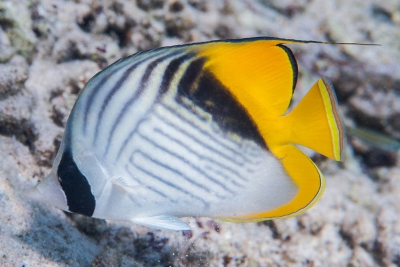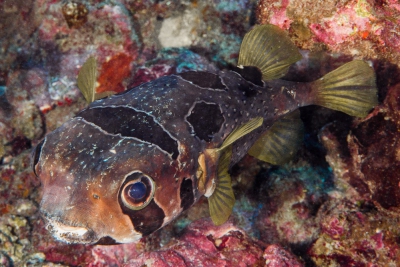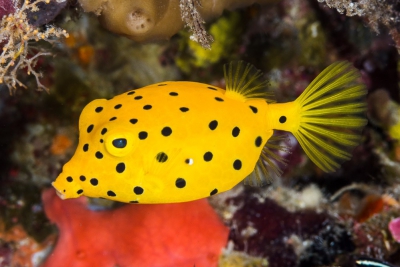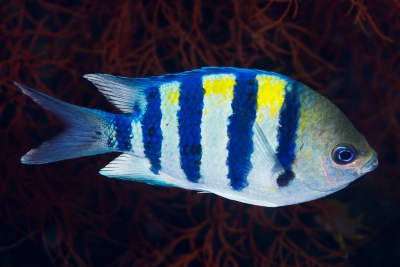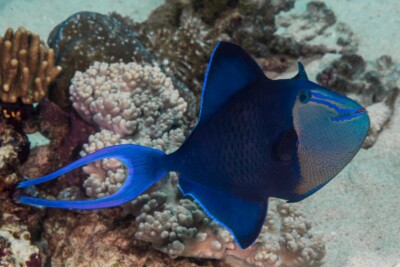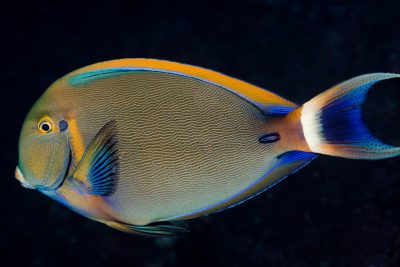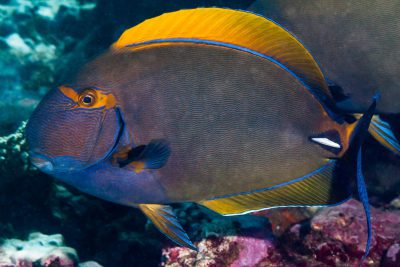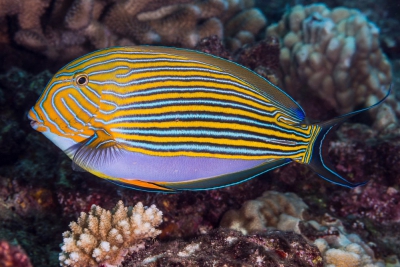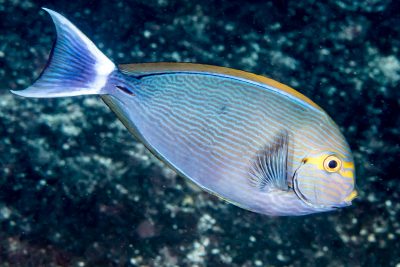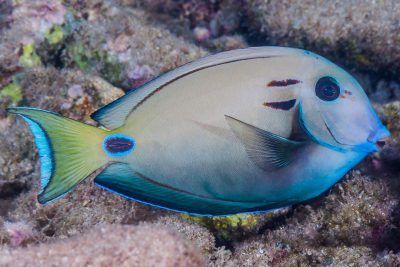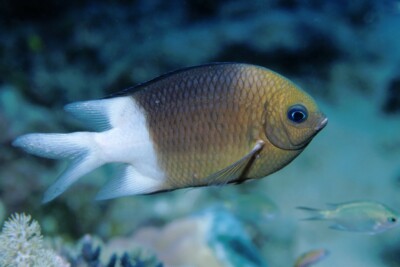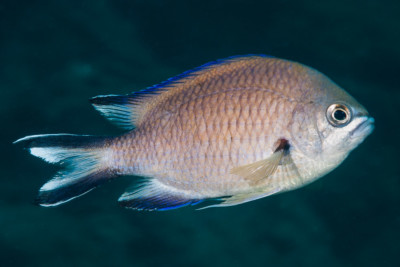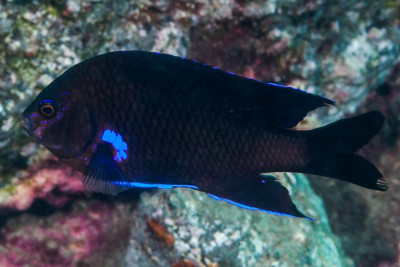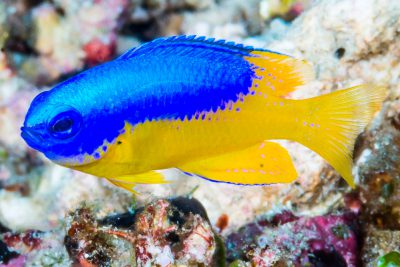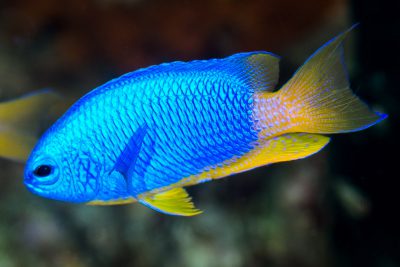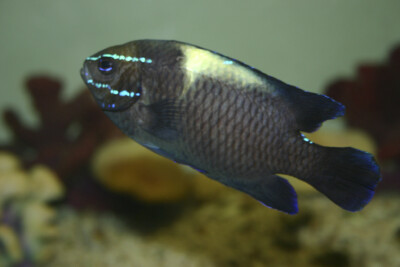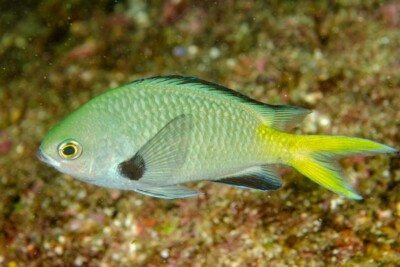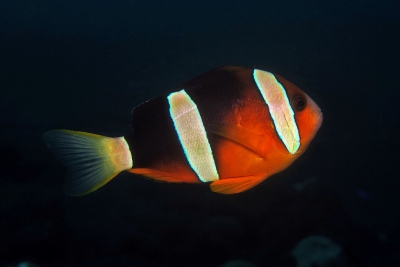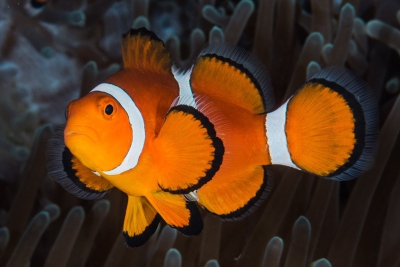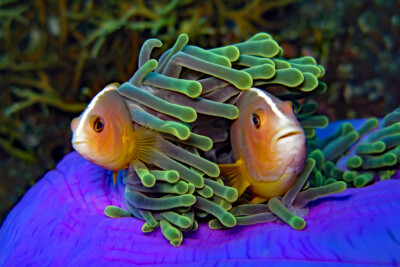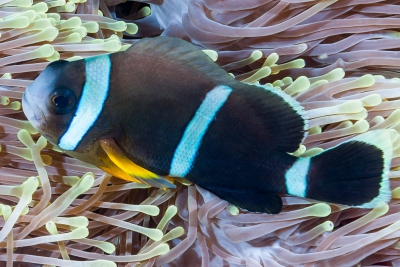clark's anemonefish
| Scientific name | Amphiprion clarkii |
|---|---|
| Descriptor | Bennett |
| Year of description | 1830 |
| IUCN category (World) | LC |
| Family | Pomacentridae |
| Genus | Amphiprion |
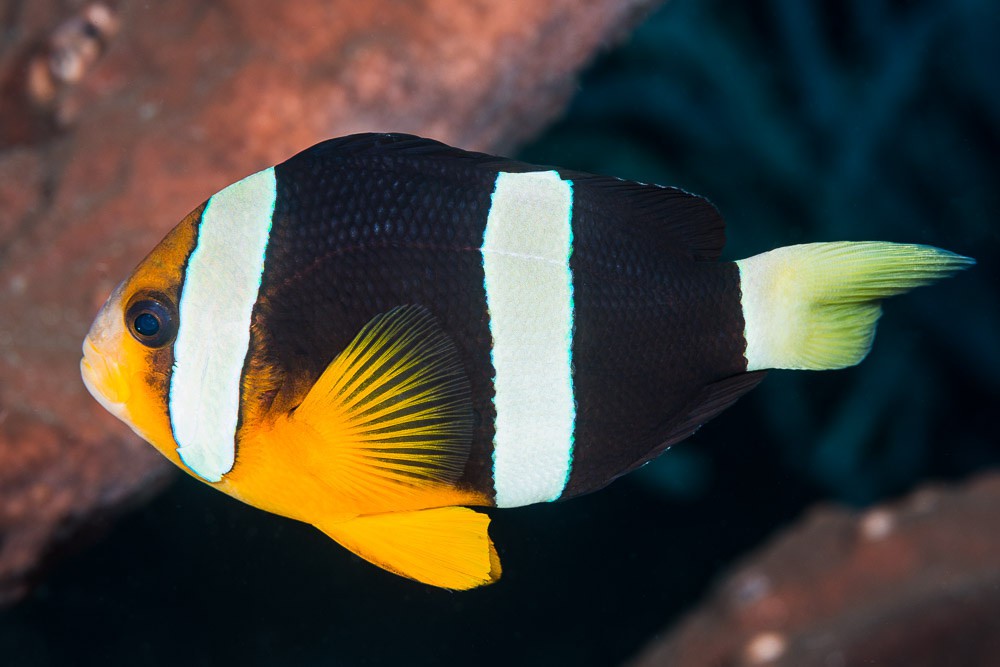

Introduction
Amphiprion clarkii is commonly known as the "Clark's anemonefish. Found in a large part of the Indo-Pacific region, it goes by over a dozen names depending on the region. Capable of living in numerous species of anemone, it is the least picky anemonefish in terms of hosts.
Who is it?
Morphology
-
Type
-
Average size10 cm
-
Maximum size15 cm
-
Longevity15 year
-
ShapeOval
-
Patternhorizontal stripes
-
Type
-
Average size10 cm
-
Maximum size15 cm
-
Longevity15 year
-
ShapeOval
-
Patternhorizontal stripes
How to recognize This fish ?
Initially, Clark's anemonefish was described under the genus Anthias from specimens collected in Sri Lanka.
The body is black with varying amounts of orange on the head, fins, and ventral parts. The species commonly has three white bands on the body and a white or yellow caudal fin. Its wide geographic range has led to many color variations depending on the region. An exception exists from Vanuatu to New Caledonia: Adults and juveniles there can be entirely orange with only two white bars.
Although there are other orange and black anemonefish of similar form, Clark's anemonefish can be distinguished by the number and size of the white bands. The distinction can also be made based on the color of the caudal fin.
Sexual dimorphism
The female is larger. Males may have a white caudal fin with yellow edges.
Behaviour & Life cycle
-
dietomnivorous with carnivorous tendency
-
Sociabilityliving as a couple
-
territorialYes
-
Way of livingdiurnal
This species is known to emit sounds easily audible by humans.
This fish follows the typical lifestyle of species in the genus Amphiprion. Territorial, it lives symbiotically with an anemone and feeds on its scraps, small plants, and microorganisms. It is found in colonies organized around a dominant female.
It is adapted to numerous anemone species including: Cryptodendrum adhaesivum; Entacmaea quadricolor; Heteractis aurora; H. crispa; H. magnifica, H. malu; Macrodactyla doreensis; Stichodactyla gigantea; S. haddoni; S. mertensii.
Reproduction
-
Reproductionovipare qui pond sur substrat découvert
-
Hermaphroditeprotandric
Clark's anemonefish is oviparous, laying eggs on exposed surfaces.
Harmless species
This species poses no particular danger to humans when encountered in its natural habitat.
Origin and distribution
What is its habitat?
Natural environment characteristics
-
Temperature22 - 26 °C
-
Depth0 - 30 m
-
FlowMedium
Biotope presentation
Clark's anemonefish can be found in coral reefs and anemone zones, at depths less than 30 meters.
Species of the same biotope
Main recommendations for fishkeeping
Deontology
In order to preserve wildlife, if you acquire this animal, it must not be released into the wild. See also, the Fishipedia charter.
Fishipedia supports the practice of responsible and environmentally friendly aquarium keeping. We encourage maintenance if it is motivated by a desire to understand the biological functioning of living things and if it is done with respect for animal life.
We believe that aquaristics is an opening to the discovery of aquatic environments, especially freshwater, and that this knowledge is necessary to better protect and respect these environments. Logically, we refute the compulsive purchase of animals that would not find a sufficient and / or adapted place in the host aquarium.
Our recommendationsThese tips apply to adult species from breeding. With regards to water conditions, wild species or close relatives must be kept under the same conditions as in their area of origin.
-
Min volume200 liters
-
Population min1
-
Temperature22 - 26 °C
-
pH (acidity)8.2 - 8.4
CharacteristicsThe characteristics below apply for adult species. They correspond to an average of cases, validated in maintenance condition.
-
Difficulty breedingThe farming difficulty is relative. It depends on experiments already carried out with similar species. First, it takes into consideration the robustness of the species, the ease of recreation of a favorable environment and the general behaviour with the other inhabitants of the aquarium.moderate
-
Robustnesstolerant
-
Behaviourslightly aggressive
-
Availabilitystandard
General reminders
It is strongly advised to read the complete dedicated file and to get information on the feedbacks of maintenance of the envisaged animal, this to avoid any potential conflict whose end result is generally the death of the individual (or the other inhabitants). It is important not to overload your aquarium to limit pollution. This will make maintenance easier.
General reminder on maintenance datas
Le démarrage d'un aquarium est une partie primordiale pour l'équilibre et le bien-être des poissons. Lorsque l'on met en eau un aquarium, l'eau passe naturellement par un cycle biologique : le cycle de l'azote. Celui-ci dure environ trois semaines. Tous les 2 jours, nous vous conseillons de tester votre eau jusqu'à ce que le taux de nitrite soit à zéro pendant plusieurs jours d'affilée.
Pour accélérer ce cycle, vous pouvez utiliser un activateur de bactéries comme JBL Denitrol. Cette solution riche en bactéries vivantes et enzymes permet une mise en place rapide du cycle de l'azote. Les poissons peuvent alors être introduits plus rapidement.
Il est important de tester l'eau de son aquarium régulièrement pour maintenir un environnement sain pour les poissons et les autres habitants. Les tests d'eau permettent de mesurer les niveaux de différents paramètres tels que le pH, la dureté totale, ainsi que les taux de nitrates, de nitrites et d'ammoniaque.
Pour réaliser ces tests, vous pouvez utiliser des produits d'analyse spécialisés tels que JBL ProScan qui permet de réaliser un diagnostic de l'eau directement via un smartphone. Il existe également des coffrets de tests plus classiques de bandelettes, comme JBL PROAQUATEST.
En cas d’usage de l’eau du robinet, vous pouvez utiliser un conditionneur d’eau de type Biotopol de JBL pour éliminer les substances nocives comme le chlore, le cuivre, le plomb et le zinc. Les conditionneurs d'eau garantissent une meilleure santé aux poissons et une meilleure croissance des plantes.
Chlorine and chloramine are dangerous for the health of animals. Used to disinfect water, these agents are present in significant quantities in tap water. We recommend using an anti-chlorine agent every time you change the water. In addition to chlorine, treatments and medicines sold for aquarium use sometimes contain dangerous heavy metals in high doses.
Specific needs for the clark's anemonefish
The clark's anemonefish is a marine species which lives naturally at a temperature between 22 °C and 26 °C. For proper maintenance, the temperature should never exceed the 29°C for long periods. Nitrate levels should remain below 50mg/L. To keep the water clean and unpolluted, plan on changing 20% to 30% of the water volume each month. In seawater, it is also possible to remove nitrates using one of the following methods: Jaubert, denitrator on sulfur, biopeletts, vodka method.
The breeding of this species is accessible on condition of being well informed about its needs in aquarium . Any cohabitants must be chosen with care to avoid the loss of animals.
Cohabitation & Environment
In a community aquarium context, this species should be kept in a minimum volume of 200 liters.
The clark's anemonefish may show signs of aggression. In general, this species should not be mixed with large territorial species or other overly aggressive species, in order to avoid possible stress or even injury.
However, it can coexist with other species with a peaceful temperament and with some slightly territorial neighbors, as far as the volume of the aquarium allows. It is important to avoid that two territorial species share the same living area in an aquarium of insufficient volume. During the breeding season, this species defends its territory with more virulence. This behavior can weaken its shy neighbors.
Tips for feeding
The clark's anemonefish is omnivorous with carnivorous tendency.
This species can eat dry food (flakes, pellets), fresh food and frozen food. To avoid deficiencies, it is recommended to vary the types of food.
You should not overfeed your residents to avoid polluting the water. For most species, it is better to feed a few small portions each day rather than one large meal.
Reproduction protocol
-
Maintenance difficultymoderate
-
Spawning cleaningFemale & Male
-
egg-laying protectionFemale & Male
-
Fry protection
Hybridization risks
In general, it is advised not to mix several species of the same genus or different varieties of the same species, to avoid the risks of hybridization.
These animals might interest you
To go further
Sources & Contributions
Participation & Validation
The Fishipedia team and specialist contributors are committed to providing high-quality content. However, although the information comes from scientific sources or testimonials from specialists, the cards may contain inaccuracies.

Adrien Falzon

Benoit Chartrer
Translation
Translation done with the valuable contribution of our translators, who make this information available to a wider audience. We sincerely thank them for their commitment.
Bibliographic references
FIELD GUIDE TO ANEMONE FISHES AND THEIR HOST SEA ANEMONES - Dr. Daphne G. Fautin - GERALD R. ALLEN - Western Australian Museum - 1992.
POMACENTRIDAE - GERALD R. ALLEN - FAO Fisheries Synopsis - 2001. ISBN 92-5-104587-9
Evolution, Development and Ecology of Anemonefishes - Vincent Laudet - Timothy Ravasi - Taylor & Francis - 2023.
Scientific partners
Tags
Species of the same family
Same genus
Species of the same biotope
